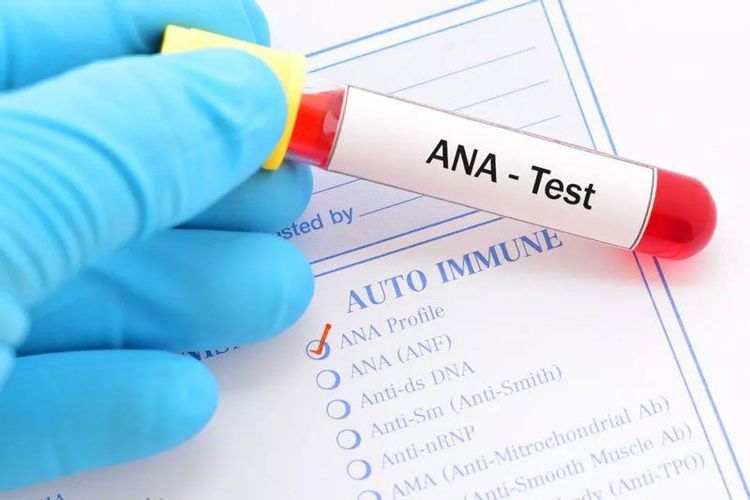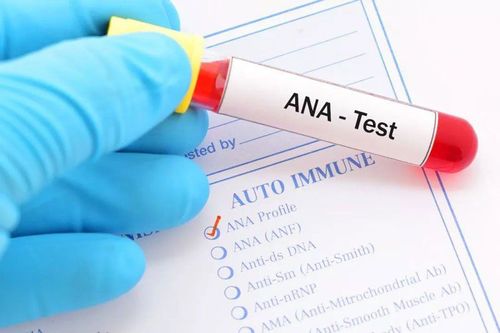This is an automatically translated article.
The ANA test is used to detect antinuclear antibodies in the blood. The immune system normally produces antibodies to help the body fight infections. In contrast, antinuclear antibodies often attack the body's own tissues - specifically targeting the nucleus of individual cells - which is the mechanism of autoimmune response, in autoimmune diseases such as lupus, arthritis. rheumatoid arthritis or scleroderma.
1. What is an antinuclear antibody test?
Antinuclear antibodies (ANA) are a group of autoantibodies produced by a person's immune system when the body's immune system fails to adequately distinguish between "self" and "not". must be yourself". The ANA test is intended to detect these autoantibodies in the blood.
ANA reacts with components of the body's own healthy cells and causes signs and symptoms such as inflammation of tissues and organs, joint and muscle pain, and persistent fever. ANAs specifically target substances found in the nucleus of cells. Although they cannot damage living cells because they cannot reach their nucleus, ANAs can still cause tissue damage by reacting with substances in the nucleus when released from damaged cells. or necrosis.
The ANA test is one of the main tests to help diagnose suspected autoimmune disorders or rule out other conditions with similar signs and symptoms. The ANA test can be positive for some autoimmune disorders. Specifically, patients with systemic lupus erythematosus due to an autoimmune disorder are almost always ANA-positive. However, the proportion of patients with other autoimmune disorders who have positive ANA results varies. In addition, a significant number of patients with other medical conditions, and even some otherwise healthy individuals, may test positive for ANA, but only to a limited extent.

Bệnh nhân mắc bệnh lupus ban đỏ hệ thống do rối loạn tự miễn dịch hầu như luôn dương tính với ANA
The body that performs ANA testing at different laboratories may use different test methods to detect and measure ANA levels, including:
Methods using indirect fluorescent antibodies : This method is the traditional method. A person's blood sample is mixed with cells that are glued onto a slide. Autoantibodies that may be present in the blood will react with the cells. The slides were treated with fluorescent antibody reagents and examined under a microscope. The presence (or absence) and fluorescence pattern will be noted for the qualitative and quantitative analysis of ANA.
Immunoassay Methods: Laboratories may also use immunoassays to screen for ANA and may only use indirect fluorescent antibody methods to reconfirm positive results, or The result is not clearly positive or negative. In this method, the specimen is taken on an automated measuring device, so it may be less sensitive than the indirect fluorescent antibody method in detecting ANA but may be more specific for other methods. other autoimmune disorders.
2. When is an antinuclear antibody test indicated?
ANA testing is indicated when a patient has signs and symptoms suspected of being due to a systemic autoimmune disorder. Accordingly, people with autoimmune diseases may have a variety of vague and nonspecific symptoms that change over time, worsen, or alternate between periods of flare and remission.
Some examples of signs and symptoms include:
Low-grade fever Persistent fever Persistent fatigue, weakness

Sốt nhẹ kéo dài có thể là một trong những dấu hiệu rối loạn tự miễn dịch toàn thân
Arthritis-like pain in one or more joints Red rash; for lupus with a distinctive butterfly-shaped erythema on the nose and cheeks Sensitive skin to light Hair loss Muscle pain Numbness or tingling in the hands or feet Inflammation and damage to organs and tissues, including the kidneys , lungs, heart, lining of the heart, central nervous system and blood vessels
3. What does a positive ANA test result mean?
A negative ANA reading means that there are no autoantibodies in the body. However, a positive ANA score does not necessarily mean an autoimmune disease.
The rate of positive ANA results in healthy individuals is about 3 - 15% in the general population. The production of these autoantibodies is highly age-dependent and will increase to 10-37% in healthy individuals over 65 years of age. Even healthy people infected with the virus can have a positive ANA, albeit for a short time. In addition, cancer can also cause ANA to be positive.
Certain medications can also cause a positive ANA test result. It's important to tell your doctor about all the medications you're taking - prescription, nonprescription, and dietary supplements.
Thus, a positive ANA result is simply the foundation for doctors to continue looking for a cause. In fact, a normal person can still have a positive ANA without any clinical manifestations, which means that there is not enough evidence to diagnose lupus or any other autoimmune disease. Therefore, to make a definitive diagnosis of this group of diseases, the doctor will need additional evidence in other blood tests, along with a history of symptoms as well as a general examination.

Kết quả xét nghiệm ANA là một trong những nền tảng để bác sĩ tìm kiếm nguyên nhân gây bệnh tự miễn
4. Limitations of the ANA . test
Low levels of ANA may be experienced in up to 40% of healthy individuals. Faced with this situation, most laboratories will limit reporting positive ANA, in order to actively exclude the majority of results that are low concentrations and not clinically meaningful. However, at least 5% of the healthy population with mean ANA titres were considered positive; This rate is relatively higher in women and the elderly.
In addition, the nonspecificity of the ANA test as a positive ANA result is also seen in a number of conditions that are not diagnostically useful, including non-autoimmune conditions such as chronic infections malignancies, viral hepatitis and malignancies, and some autoimmune conditions such as multiple sclerosis or thyroid disease for which the presence or absence of ANA does not play an important role in diagnosis or prognosis.
On the other hand, many patients with certain autoimmune diseases may also not have a positive ANA result. Although the ANA test is highly sensitive for some rheumatic diseases such as systemic lupus erythematosus and systemic scleroderma, a negative result does not rule out a variety of other conditions including arthritis. rheumatoid arthritis, degenerative spondyloarthritis, idiopathic inflammatory myopathy, and autoimmune vasculitis.
In summary, the antinuclear antibody (ANA) test is widely used as a serological marker of autoimmune disease. When indicated and used selectively, the ANA test can be a useful tool to help confirm or rule out a diagnosis of systemic autoimmune disease. However, because the rate of ANA positivity is relatively high in other inflammatory conditions, as well as in healthy individuals, this result requires a strong argument based on clinical and laboratory evidence. another before drawing a final conclusion.
Any questions that need to be answered by a specialist doctor as well as customers wishing to be examined and treated at Vinmec International General Hospital, please contact the Website for the best service.
Please dial HOTLINE for more information or register for an appointment HERE. Download MyVinmec app to make appointments faster and to manage your bookings easily.













